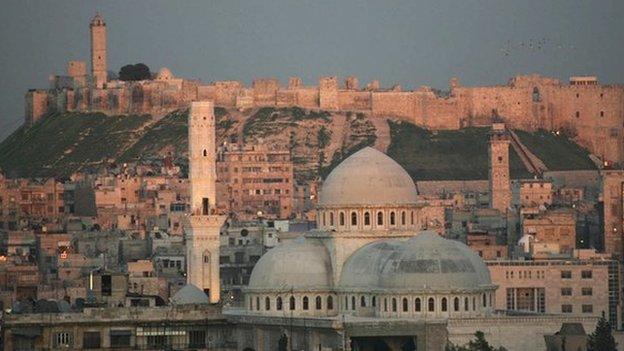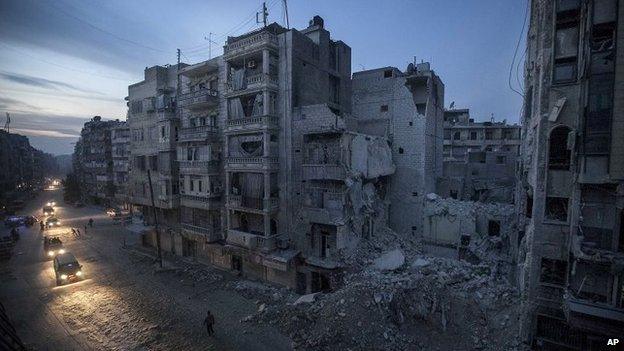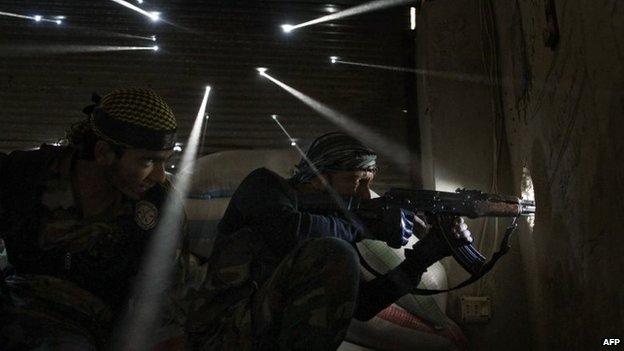Profile: Aleppo, Syria's second city
- Published

The Old City of Aleppo - seen here in 2006 - is listed by Unesco as a World Heritage site
Aleppo was once Syria's largest city and the country's industrial and financial centre.
For the first year of the uprising against President Bashar al-Assad, Aleppo saw neither the large-scale protests nor the deadly violence that shook other towns and cities.
However, it suddenly became a key battleground in July 2012, when rebel fighters launched an offensive to oust government forces and gain control over northern Syria.
But the rebel advance was not decisive and Aleppo ended up divided roughly in half, with the opposition controlling the east and the government the west.
Neither side was able to break the deadlock until mid-2016, when government troops backed by Russian air strikes severed the rebels' last route into the east and placed 250,000 people under siege.
At the end of November, troops retook the north of the rebel enclave, in what could prove to be a turning point in the Syrian conflict.
Ancient city
Aleppo, or "Halab" in Arabic, is one of world's oldest continually inhabited cities, being mentioned in Egyptian texts from the 20th Century BC.
Remains of a temple from the end of the third millennium BC have been found at the site of Aleppo's famous mediaeval citadel, which still dominates the area and provided a defensive stronghold for centuries.
BBC archive footage from the 1990s gives a sense of why Aleppo was once considered "the jewel of Syria"
Aleppo flourished politically and economically during the 18th Century BC as the capital of the kingdom of Yamkhad, until it fell to the Hittites.
Later, it became an important city of the Hellenistic period and a key trading post for merchants passing between the Mediterranean and lands to the east. It was eventually absorbed into the Roman Empire and then prospered as a hub for caravan traffic under Byzantine rule.
In 636 AD, Aleppo was conquered by Arab Muslim troops. About 80 years later, during the rule of the Umayyad Caliph Sulaiman, its Great Mosque was built.
In the 10th Century, Aleppo became the capital of the northern Syrian Hamdanid dynasty, but it then suffered a period of war and disorder, as the Byzantine Empire, Crusaders, Fatamids and Seljuks fought to gain control of it and the surrounding region.
Aleppo did not recover until the middle of the 12th Century. Then, under Ayyubid rule in the 13th Century, the city enjoyed a period of great prosperity and expansion.
But this came to an abrupt end in 1260, when Aleppo was conquered by the Mongols. The city then suffered an outbreak of plague in 1348 and a devastating attack by Timur in 1400.

Travellers and merchants have passed through Aleppo for millennia
In 1516, Aleppo became part of the Ottoman Empire. It was soon made the capital of its own province and emerged as a nexus of trade between the Orient and Europe.
Aleppo's role as a transit centre for trade declined in the late 18th Century and was hindered further by France and Great Britain's demarcation of the borders of modern Syria - which cut the city off from southern Turkey and northern Iraq - and the loss of the Mediterranean port of Alexandretta to Turkey in 1939.
Following Syrian independence, the city developed into a major industrial centre, rivalling the capital Damascus, and its population expanded massively from 300,000 to about 2.3 million by 2005.
Today, Aleppo's population is made up mainly of Sunni Muslims, most of whom are Arabs but some of whom are Kurds and Turkomans. The city also has the largest population of Christians in Syria, including many Armenians, as well as Shia and Alawite communities.
War of attrition
When anti-government protests erupted across Syria in March 2011, the authorities did everything possible to ensure they did not take hold in Aleppo.
The threat of brutal reprisals helped limit demonstrations largely to outlying districts of the city and the university.

Since mid-2012, Aleppo has been a key battleground
However, as the uprising evolved into a conflict, Aleppo was soon caught up in the unrest.
In February 2012, the city was rocked by two bomb attacks on military intelligence and police compounds that left 28 people dead.
Then, clashes between armed rebels and government forces began to be reported with increasing frequency in nearby areas of Aleppo province.
The battle for the city of Aleppo began in mid-July 2012. The rebels made swift gains, seizing control of several pro-opposition districts in the north-east, south and west.
By the end of the month, the fighting had intensified and spread to the historic city centre, even reaching the gates of the Old City, a Unesco World Heritage site.
In September 2012, a blaze swept through the ancient souk after clashes in the vicinity, while in April 2013 the Great Mosque's 11th Century minaret was reduced to rubble.
Within months the battle for Aleppo became a war of attrition. Most of the territory is disputed and the frontlines are shifting constantly.
The rebels have been unable to acquire the heavy weapons they need to defeat the better-equipped government's forces, while the military had its supply lines disrupted and had to focus resources on Damascus, where a rebel offensive also began in July 2012.

Neither side was able to break the military deadlock in Aleppo for four years
Since the end of 2013, government forces have waged a deadly aerial campaign in Aleppo using barrel bombs, allowing them to make several gains.
Rebel forces have been dogged by infighting between the so-called Islamic State (IS) and other jihadist groups.
In May 2015, Amnesty warned life had become "increasingly unbearable" for civilians, accusing government forces and rebel groups of committing war crimes.
Under siege
Life in rebel-held Aleppo became increasingly difficult that September, when Russia launched air strikes in support of President Assad.
Moscow said it would only targets jihadist militants, but soon Western powers were accusing it of hitting mainstream rebels and civilian areas.
The Russian intervention enabled government forced to advance on several fronts.
Aleppo: Key battleground in Syria's civil war
In February 2016, government forces broke a long-running rebel siege of Nubul and Zahraa, two Shia villages north-west of Aleppo, and severed the main supply route from Turkey into the rebel-held east.
The rebels suffered another major blow in July when government forces took control of the Castello Road, a major artery that runs into eastern Aleppo, trapping 275,000 people living there.
In early August, rebel forces based outside the city captured the government-controlled Ramouseh district and opened up a new corridor into the east. But a month later, troops retook the territory and resumed the siege.

The government announced the launch a large-scale offensive on 22 September. It was accompanied by an aerial bombardment of unprecedented scale and intensity that reportedly included bunker-busting, incendiary and cluster munitions.
A pause in the air strikes was declared unilaterally on mid-October to allow civilians and rebels to leave the east, but very few people took up the offer.
On 15 November, the government air campaign resumed and troops stepped up their ground offensive. By the end of the month, they had pushed into several northern districts, prompting thousands of people fled their homes.